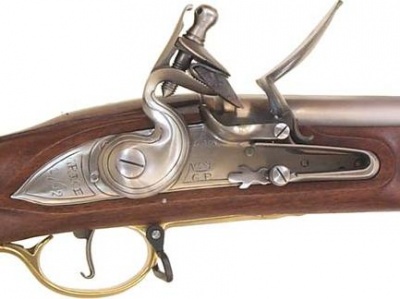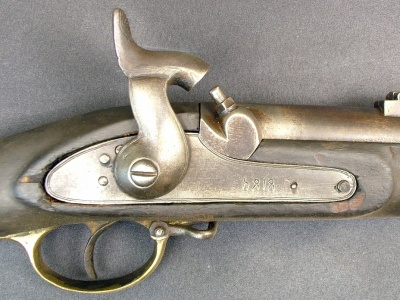| If you have been locked out of your account you can request a password reset here. |
Guide to Muzzleloaders
As muzzle-loaders are the most frequently mis-identified firearms on the site, I'm creating a simple guide to their understanding and identification.
Flintlock vs Percussion
The flintlock, introduced in France in the early 17th century, was the first practical method of firing a gunpowder weapon without using a burning match. It used a piece of flint held in a set of jaws called a cock, striking a piece of steel called a frizzen, igniting a small powder charge in a flash pan. This would then ignite the main charge.
The percussion lock, otherwise known as a caplock, was introduced in England and America in the 1820s. It used a hammer striking a fulminate of mercury cap on a nipple, the flame of which would then ignite the main charge. This was significantly simpler, faster and more reliable than the flintlock.
Musket vs Rifle
The term "musket" refers specifically to smooth bore firearms without rifling, which are inherently inaccurate and can typically only be used to about 75 yards. Rifles refers to rifled firearms, whether breech or muzzle loading. When rifles were first introduced to military use in the late 18th century, they were a specialist weapon used by soldiers separate from the musket-armed line infantry, as although they were far more accurate they could take up to a minute to load. When the introduction of the Minie ball in the 1850s speeded loading, allowing all infantry soldiers to be armed with rifled weapons, the rifles adopted were of musket length and sometimes referred to as rifle-muskets. Rifle units typically received as shortened version of the infantry rifle-musket, referred to simply as a rifle. This practice was gradually abandonned by the 1870s (earlier in the United States due to the Civil War) and all firearms were simply referred to as rifles.
The term musket enjoyed a brief revival in late 19th and early 20th century America as a marketing term used by various companies to refer to the militarized versions of their commercial products. Thus the militarized Winchester 1866 as used by the Turkish army was referred to as the Winchester 1866 Musket, and so on, however this was not a technical term and further details are outside the scope of this article.
Common Flintlocks
Brown Bess Musket
Used by the British military from 1722 to about 1840, most notably in the American revolution and the Napoleonic wars. Also used by the American Continental Army prior to the introduction of the Charleville, British East India company and Mexican army 1836-1848. Idenfifiable by it's pin-retained barrel, ramrod pipes and plain nosecap.
Charleville Musket
Used by the French military from 1763 to abput 1840, most notably in the American and French revolutionary wars and the Napoleonic wars. Most nations adopted similar weapons at the time. Identifiable by it's barrel bands and funnelled nose cap.
Jaeger Rifle
Short, heavy caliber rifle used for hunting boar and deer in German forests. As huntsmen ("jaegers") was a middle-class profession in pre-industrial Germany, the rifles were often quite ornate. The Jeager rifle is believed to have originated in the late 17th and early 18th centuries. They can be idenfified by their short length, stock to the muzzle, sliding wood patch box and whole hand trigger guard spur.
Pennsylvania Rifle
Evolved from the Jaeger rifle, with a longer barrel for longer range shots in the more open American wilderness, and of smaller caliber to reduce lead consumption, the Pennsylvania rifle, also sometimes known as a Kentucky rifle, was a distinctly American design which saw some use among militia troops during the American revolution. They can be identified by their long length, stock to the muzzle (sometime with brass endcap), curved butt and brass patchbox.
Baker Rifle
Introduced in 1800, the Baker rifle was the British military's first issued rifle, based on German Jaeger rifles carried by German mercenaries employed by the British during the American revolution. It was famous for it's use by the Rifle Corps during the Napoleonic Wars and would have a long life as surplus weapons in North American afterwards. They can be identified by their short length, pinned in barrel, brass patchbox and bayonet bar.











